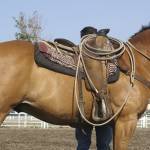HERDA: Public Perception of this Collagen Disorder in Horses

Ask horsemen involved in cattle events if they’ve heard of the disorder known as heritable equine regional dermal asthenia (HERDA), and the answer is probably yes. Do the same horsemen know details of the disease or of concerns swirling around breeding affected horses? A recent study set out to determine industry perceptions of HERDA in performance horses.1
To achieve a better understanding of the disease, look no further than the name itself:
- Heritable: transmissible from parent to offspring
- Equine: of, relating to, or resembling a horse or the horse family
- Regional: localized, affecting a particular region
- Dermal: pertaining to the dermis or fibrous inner layer of the skin
- Asthenia: loss of strength
While dissecting its name offers clues to the disease, this exercise doesn’t exactly establish how it affects horses. Severely affected horses experience spontaneous skin sloughing, lacerations, and hematomas from minimal trauma, usually in areas that come into contact with tack or other equipment, resulting in extensive and sometimes disfiguring scarring of the withers, back, and loin. The disease is usually not noticed until horses are placed into training and are asked to work under saddle. Pressure from the saddle causes the skin to tear and blister. Because there is no cure for the disease, horses affected by HERDA are often euthanized.2
In the aforementioned study, knowledge regarding HERDA was gathered through an online survey. Researchers collected 228 usable responses. Respondents reported diverse involvement in the horse industry, with about half competing in reining, cutting, or reined cow horse events. The majority of the respondents described being “extremely familiar” or “very familiar” with HERDA.
Researchers learned:
- When placed in a hypothetical scenario as a stallion owner, about 57% of respondents stated they would provide rebreed services to a mare if the first offspring was HERDA-positive.
- More than 95% of survey participants felt that HERDA status should be readily available to all breeders. A simple genetic test can determine normal, carrier, and affected status.
- Respondents (79%) indicated they would breed HERDA carriers to noncarriers.
- HERDA status would more likely affect the purchase price for more respondents.
According to the researchers, these points “indicate an increase in owner and breeder responsibility in choosing appropriate pairings.”
The management of heterozygous carriers (one normal gene, one HERDA gene; no disease expression) seems to be most challenging. Breeding decisions for heterozygous mares are more difficult as many of the top stallions in the industry are carriers, which would result in a 25% chance that the offspring will be HERDA-positive and a 50% chance of it being a carrier.
Mildly affected horses can be provided with some nutritional support from a well-formulated diet that includes appropriate levels of protein and trace minerals, including copper and selenium. The antioxidant vitamin C is of especial importance. In certain instances, high-quality joint support products may be beneficial, as some horses could also have joint-related issues stemming from the disease.2
1Walker, N.L., A.R. Patout, and M. Cater. 2020. Industry perceptions of HERDA in performance horses. Journal of Equine Veterinary Science. In press.
2Rashmir-Raven, A. 2013. Heritable equine regional dermal asthenia. Veterinary Clinics of North America Equine Practice 29:689-702.








